As a Filipino, pancit was always our celebration dish. But it wasn't until I visited Bicol that I discovered Pancit Bato Guisado.
Every time I make this dish now, I'm transported back to Camarines Sur, where I found out how these uniquely textured noodles from the town of Bato could transform an ordinary pancit into something extraordinary.
Unlike the smoother pancit canton we're used to in Manila, these special noodles have this wonderful ability to really grab onto the savory sauce. It's like every bite delivers more flavor.
After years of making different pancit recipes, this Pancit Bato Guisado has become my ultimate comfort food. There's something so satisfying about watching the noodles soak up that flavorful combination of chicken broth, toyo and patis, while the liempo gets perfectly tender and the hipon (shrimp) adds that sweet seafood taste that we Filipinos love.
It's simpler to make than you'd think, and I'll show you exactly how I learned to get it just right.
Jump to:
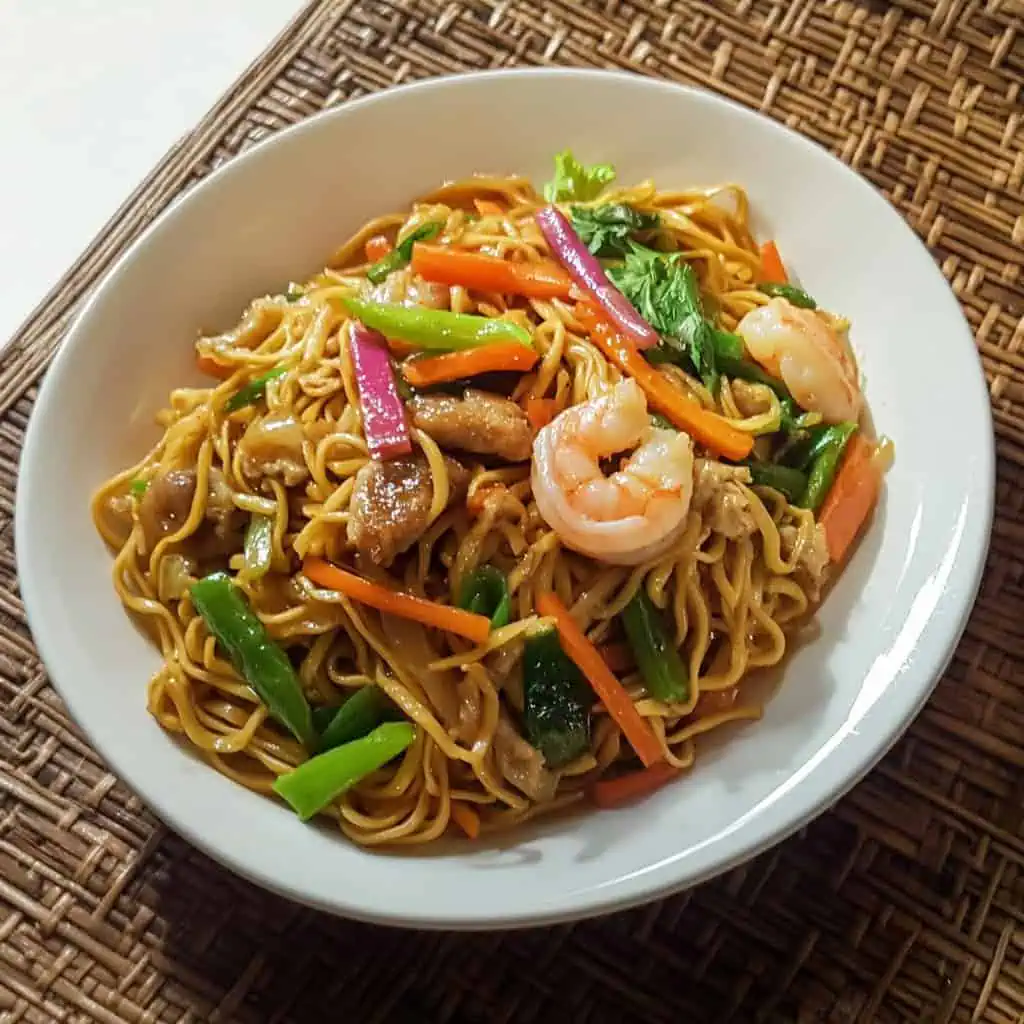
Why You'll Love This Recipe
- Authentic Bicol flavors passed down through generations
- Perfect balance of textures from vegetables and proteins
- Customizable to your taste preferences
- Great for special occasions or everyday meals
- Meal prep friendly
- Budget-friendly yet impressive
- Rich in proteins and vegetables
Ingredients
Each component in this recipe serves a specific purpose. The textured Pancit Bato noodles act as the perfect vessel for absorbing the umami-rich sauce created from chicken broth, soy sauce, and fish sauce.
Pork belly adds richness and depth, while shrimp contributes natural sweetness. The vegetables (cabbage, carrots, and snap peas) provide freshness, crunch, and color contrast.
Garlic and onions form the aromatic foundation, while calamansi brightens everything with a touch of acidity that balances the savory elements perfectly.
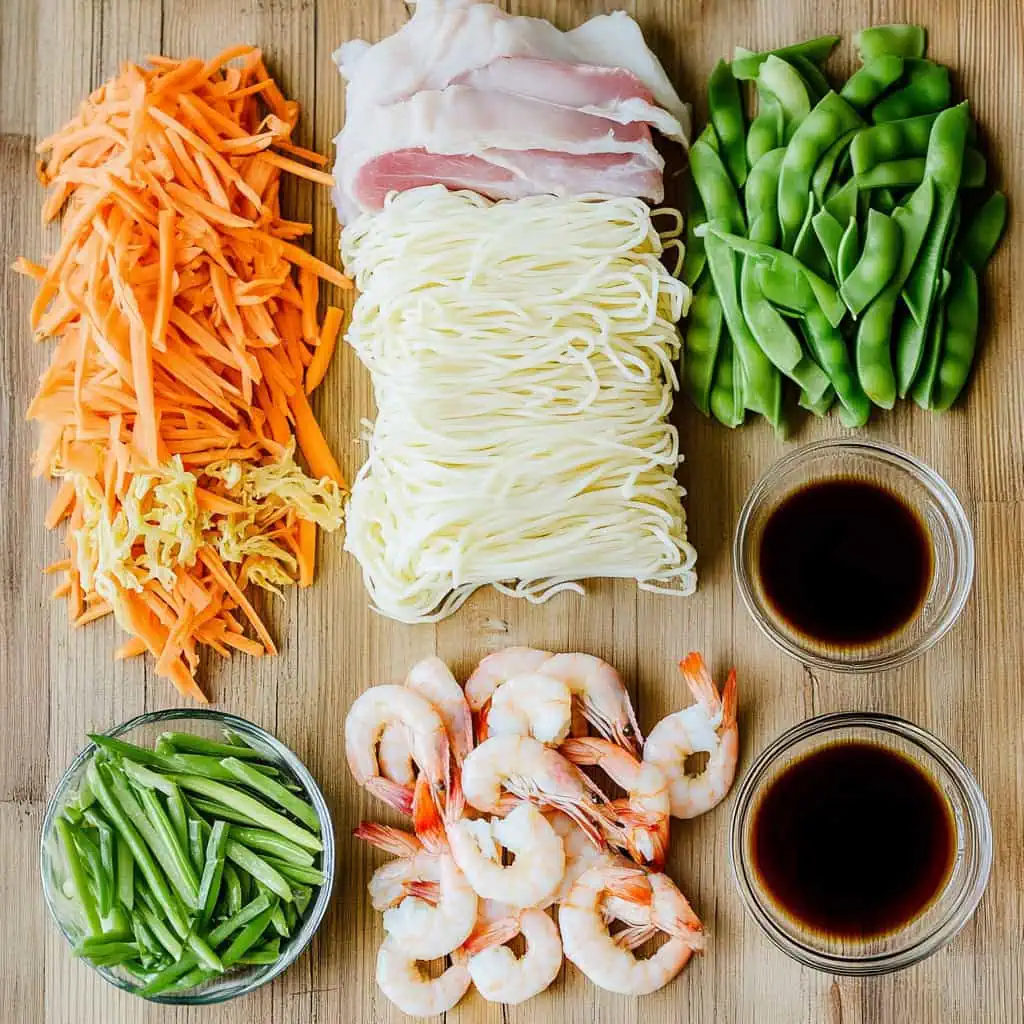
- 340 g (¾ lb) Pancit Bato noodles (miki Bato)
- 170 g (6 oz) pork belly, thinly sliced (liempo)
- 170 g (6 oz) medium shrimp, peeled and deveined (hipon)
- 2 cups chopped cabbage
- 1 medium carrot, julienned
- 1 cup snap peas
- 1 medium onion, sliced
- 2 teaspoons minced garlic
- 2 cups chicken broth
- ¼ cup soy sauce
- 2 tablespoons fish sauce
- Ground black pepper to taste
- 3 tablespoons cooking oil
- Calamansi or lemon wedges for serving
Equipment
- Large Wok or Deep Pan (Kawali) - For even heat distribution and proper stir-frying
- Sharp Knife - For precise vegetable cutting
- Wooden Spoon - To prevent scratching your cookware while stirring
- Measuring Cups and Spoons - For accurate portioning of ingredients
- Colander - For draining noodles if needed
- Cutting Board - For safe ingredient preparation
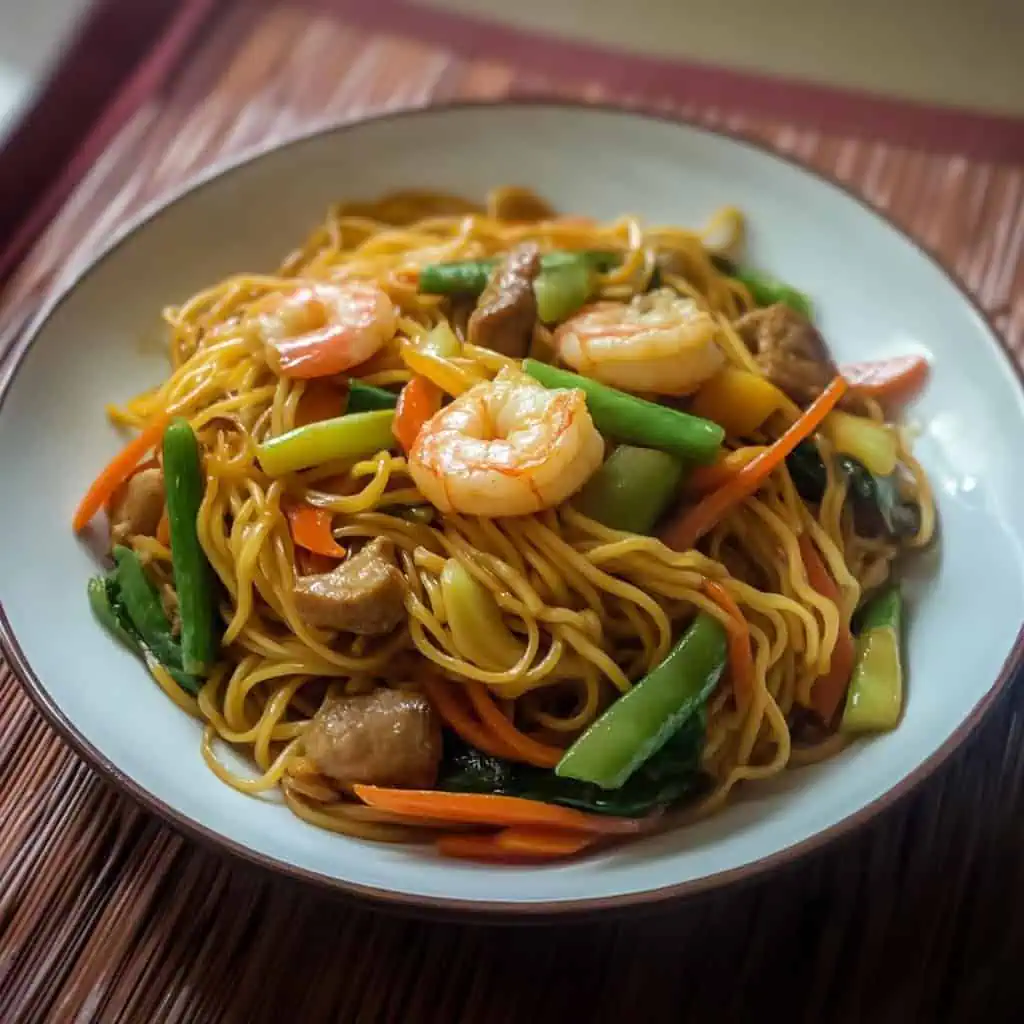
How To Make
- Prepare all vegetables: Slice onions thinly, mince garlic finely, julienne the carrots (cut into thin strips), chop cabbage into bite-sized pieces, and trim the ends of snap peas.
- Prepare the proteins: Slice pork belly into thin strips about 2 inches long and ½ inch wide. Clean shrimp by removing heads and shells, then devein.
- Heat a large wok or deep pan over medium-high heat (180°C/350°F). Add cooking oil and wait until it shimmers.
- Sauté aromatics: Once oil is hot, add minced garlic and sauté until light golden and fragrant, about 30 seconds. Don't let it brown or it will become bitter.
- Add sliced onions to the garlic. Cook until translucent and soft, stirring occasionally, about 2 minutes.
- Cook the pork: Add the sliced pork belly. Cook while stirring occasionally until the meat starts to brown and render its fat, about 3-4 minutes.
- Add sauces: Pour in the soy sauce and fish sauce. Stir to coat the meat evenly.
- Simmer the pork: Add chicken broth and bring to a boil. Once boiling, reduce heat to medium-low, cover the pan, and let simmer for 20 minutes or until pork is tender. If liquid reduces too much, add hot water ¼ cup at a time.
- Season with ground black pepper to taste. Stir well to combine.
- Add quick-cooking ingredients: Add shrimp, snap peas, and julienned carrots. Cook for 1 minute, stirring gently.
- Add cabbage and cook for another 2 minutes. Vegetables should remain crisp-tender.
- Add the noodles: Add the pancit bato noodles. Using two wooden spoons or spatulas, gently toss and mix the noodles with the meat, vegetables, and sauce until well combined.
- Finish cooking: Continue cooking while stirring occasionally until noodles are tender and have absorbed most of the liquid, about 5-7 minutes. Test a noodle for doneness - it should be soft but still have a slight bite (like al dente pasta).
- Adjust texture if needed: If noodles are still too firm, add hot broth or water ¼ cup at a time and continue cooking until desired tenderness is reached.
- Final adjustments: Taste and adjust seasoning with additional fish sauce, soy sauce, or black pepper if needed.
- Serve immediately with calamansi or lemon halves on the side.

Tips from Lola's Kitchen
- Mise en place is crucial: Prepare and organize all ingredients before you start cooking. This dish comes together quickly once you begin cooking.
- Cut vegetables uniformly: For even cooking, try to cut all vegetables in similar sizes.
- Watch the shrimp carefully: They cook very quickly and can become tough if overcooked. Add them just a minute or two before the vegetables.
- The noodle test: Always test a noodle before serving to ensure it has reached the perfect texture - soft but with a slight bite.
- Progressive seasoning: Add salt gradually throughout cooking rather than all at once at the end. Taste as you go.
- Save some broth: Keep a cup of hot broth nearby during cooking in case your pancit becomes too dry.
- Rest before serving: Let the dish rest for 1-2 minutes after cooking to allow flavors to fully develop.
- Banana leaf presentation: For authentic serving, line your serving platter with banana leaves - they impart a subtle aroma that enhances the dish.
Substitutions
- Can't find Pancit Bato noodles? Use pancit canton or even thick egg noodles as a substitute.
- Pork alternatives: Chicken thigh fillets work well and cook faster than pork belly. For a leaner option, pork loin can be used.
- Vegetable swaps: Green beans (sitaw) can replace snap peas. Bell peppers, celery, or pechay (Chinese cabbage) make excellent additions.
- Seafood options: If shrimp aren't available, you can use squid rings or even diced fish fillets.
- Broth substitutions: Vegetable broth works well for a vegetarian version (also substitute tofu for meat).
- No calamansi? Lemon or lime wedges work as alternatives for the finishing touch.
Troubleshooting
- Dry noodles: If your noodles are too dry, add hot broth ¼ cup at a time while stirring gently until you reach the desired consistency.
- Too salty: Balance with a squeeze of calamansi juice or add a small amount of sugar to counteract the saltiness.
- Soggy vegetables: You've likely added them too early in the cooking process. For your next attempt, add vegetables later and cook them for less time.
- Tough noodles: Continue cooking with additional broth until they reach the proper tenderness. Some Pancit Bato noodles require more liquid and time than others.
- Bland flavor: Enhance with additional fish sauce or soy sauce, but add gradually to avoid oversalting.
- Sticky noodles: Try tossing more frequently while cooking and ensure you have enough oil in the pan.
Storage & Reheating
- Refrigeration: Store in an airtight container for up to 3 days.
- Best quality: For optimal taste and texture, consume within 24 hours.
- Reheating method: Warm in a pan over medium heat with a splash of water or broth to restore moisture. Stir frequently.
- Microwave alternative: Cover with a damp paper towel and heat in 30-second intervals, stirring between each interval.
- Not freezer-friendly: The texture of the noodles significantly deteriorates when frozen and thawed, so freezing is not recommended.
- Meal prep tip: If preparing in advance for an event, slightly undercook the noodles as they will continue to absorb moisture while stored.
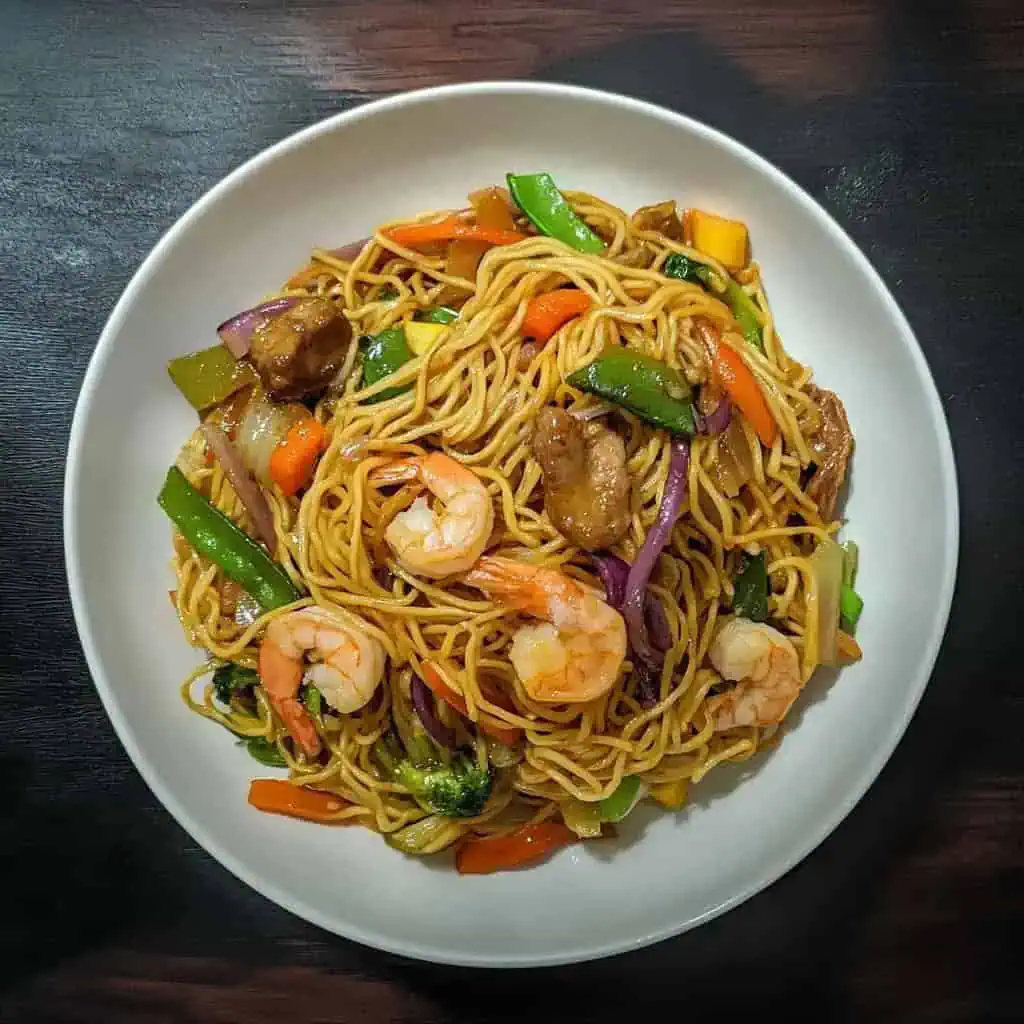
FAQ
What makes Pancit Bato different from other pancit varieties?
Pancit Bato is named after its town of origin, Bato in Camarines Sur. The noodles have a distinctive texture that's slightly rougher than regular pancit canton, which allows them to better absorb the savory sauce. This unique texture comes from the traditional manufacturing process that's been preserved for generations.
Can I make this dish ahead of time for a party?
Yes, but it's best served fresh. If you need to make it ahead, slightly undercook the noodles and vegetables, then reheat with additional liquid right before serving. This prevents the noodles from becoming mushy.
Is this recipe spicy?
The traditional version is not spicy. However, Bicol is known for spicy cuisine, so you can certainly add siling labuyo (bird's eye chilies) to taste for an authentic Bicolano kick.
How do I know when the Pancit Bato noodles are properly cooked?
They should be tender but still have a slight resistance when you bite into them (similar to al dente pasta). Cooking time varies based on the brand and thickness of noodles, so start testing after about 5 minutes of cooking in the sauce.
What's the best protein to use if I'm in a hurry?
Chicken cooks faster than pork belly, so opt for thinly sliced chicken thigh fillets if you're short on time. They'll be tender in about 5-7 minutes of simmering versus the 20 minutes needed for pork belly.
Is there a vegetarian version of Pancit Bato Guisado?
Absolutely! Replace the meat with firm tofu and mushrooms (shiitake or oyster mushrooms work well), and use vegetable broth instead of chicken broth. Omit the fish sauce and use more soy sauce or liquid aminos instead.
What makes the sauce in this dish special?
The combination of chicken broth, soy sauce, and fish sauce creates a umami-rich foundation. The pork fat that renders during cooking adds richness, while the juices from the shrimp contribute sweetness and complexity.
Can I add egg to this dish?
Yes! Many Filipino pancit dishes include scrambled eggs. Cook them separately, chop into small pieces, and add as a garnish on top just before serving.
Related
Looking for other recipes like this? Try these:
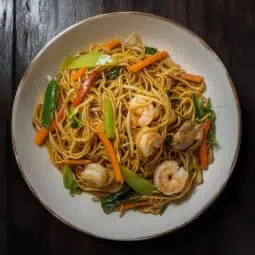
Authentic Pancit Bato Guisado (Bicol-Style Noodle Stir-Fry)
Equipment
- Large Wok or Deep Pan (kawali) For even heat distribution and proper stir-frying
- Sharp knife (kutsilyo) For precise vegetable cutting
- Wooden spoon (sandok na kahoy) To prevent scratching your cookware
- Measuring cups and spoons (Panukat) For accurate portioning
- Colander (salaan) For draining noodles if needed
- Cutting board (Sangkalan) For safe ingredient preparation
Ingredients
For the Noodles and Proteins:
- 340 g ¾ lb Pancit Bato noodles (miki Bato)
- 170 g 6 oz pork belly, thinly sliced (liempo)
- 170 g 6 oz medium shrimp, peeled and deveined (hipon)
For the Vegetables:
- 2 cups chopped cabbage repolyo
- 1 medium carrot julienned (karot)
- 1 cup snap peas sitsaro
- 1 medium onion sliced (sibuyas)
- 2 teaspoons minced garlic bawang
For the Sauce:
- 2 cups chicken broth sabaw ng manok
- ¼ cup soy sauce toyo
- 2 tablespoons fish sauce patis
- Ground black pepper to taste paminta
- 3 tablespoons cooking oil mantika
Instructions
- Prepare all vegetables: slice onions thinly, mince garlic finely, julienne the carrots (cut into thin strips), chop cabbage into bite-sized pieces, and trim the ends of snap peas.
- Slice pork belly into thin strips about 2 inches long and ½ inch wide. Clean shrimp by removing heads and shells, then devein.
- Heat a large wok or deep pan over medium-high heat (180°C/350°F). Add cooking oil and wait until it shimmers.
- Once oil is hot, add minced garlic and sauté until light golden and fragrant, about 30 seconds. Don't let it brown or it will become bitter (mapait).
- Add sliced onions to the garlic. Cook until translucent and soft, stirring occasionally, about 2 minutes.
- Add the sliced pork belly. Cook while stirring occasionally until the meat starts to brown and render its fat, about 3-4 minutes.
- Pour in the soy sauce (toyo) and fish sauce (patis). Stir to coat the meat evenly.
- Add chicken broth and bring to a boil. Once boiling, reduce heat to medium-low, cover the pan, and let simmer for 20 minutes or until pork is tender. If liquid reduces too much, add hot water ¼ cup at a time.
- Season with ground black pepper to taste. Stir well to combine.
- Add shrimp, snap peas, and julienned carrots. Cook for 1 minute, stirring gently.
- Add chopped cabbage and cook for another 2 minutes. Vegetables should remain crisp-tender (malutong-presko).
- Add the pancit bato noodles. Using two wooden spoons or spatulas, gently toss and mix the noodles with the meat, vegetables, and sauce until well combined.
- Continue cooking while stirring occasionally until noodles are tender and have absorbed most of the liquid, about 5-7 minutes. Test a noodle for doneness - it should be soft but still have a slight bite (like al dente pasta).
- If noodles are still too firm, add hot broth or water ¼ cup at a time and continue cooking until desired tenderness is reached.
- Taste and adjust seasoning with additional fish sauce, soy sauce, or black pepper if needed.
- Transfer to a serving plate lined with banana leaves if desired. Serve immediately with calamansi halves on the side.
Tips from Lola's Kitchen
- Prep all ingredients before starting (mise en place)
- Cut vegetables in similar sizes for even cooking
- Don't overcook the shrimp to keep them tender
- Test noodle texture before serving
- Season gradually and taste as you go
Nutrition
The Story Behind Pancit Bato of Bicol
Deep in the heart of Bicol region, in a charming town called Bato in Camarines Sur, lies the birthplace of one of Philippines' most distinctive noodle dishes - Pancit Bato Guisado. Don't let the name fool you - while "bato" means "rock" in Filipino, these noodles are far from hard or unpleasant. In fact, their unique texture is what makes this dish a treasured part of Bicolano cuisine.
The story of Pancit Bato begins in the early 1920s when Chinese merchants settled in the bustling town of Bato, bringing with them their noodle-making expertise. Unlike the smoother pancit canton found throughout the Philippines, these settlers developed a special noodle-making technique that produced slightly rougher-textured noodles. This distinctive texture wasn't a flaw - it was intentionally crafted to better absorb the rich flavors of local Bicolano ingredients and sauces.
Local families soon embraced these unique noodles, incorporating them into their own cooking styles. The addition of native ingredients like fresh hipon (shrimp) from nearby waters and vegetables grown in Bicol's fertile soil transformed the Chinese-inspired dish into something uniquely Filipino. What started as a simple noodle dish became a celebration of Bicol's cultural diversity and culinary innovation.
Today, Pancit Bato Guisado remains a source of pride for the people of Bato. The tradition of making these special noodles has been passed down through generations, with local manufacturers still using time-honored techniques to achieve that characteristic texture. While modern versions of the dish can be found throughout the Philippines, true Pancit Bato enthusiasts insist that the authentic noodles from Bato give the dish its unmatched flavor-holding capacity and distinctive mouthfeel.
The dish has evolved from a local specialty to become a beloved part of Filipino cuisine, particularly during celebrations and gatherings. Its popularity has spread beyond Bicol, with food lovers seeking out these special noodles for their ability to perfectly capture the savory essence of the guisado (sautéed) preparation. Whether served at fiestas, family reunions, or simple weekend gatherings, Pancit Bato Guisado represents the perfect marriage of Chinese noodle-making tradition and Filipino culinary creativity.
In recent years, this humble noodle dish has gained recognition among food enthusiasts and cultural preservationists for its unique place in Philippine culinary heritage. Food historians and chefs have begun documenting and celebrating Pancit Bato's distinctive characteristics, ensuring that this treasured recipe continues to be enjoyed by future generations of Filipino food lovers.
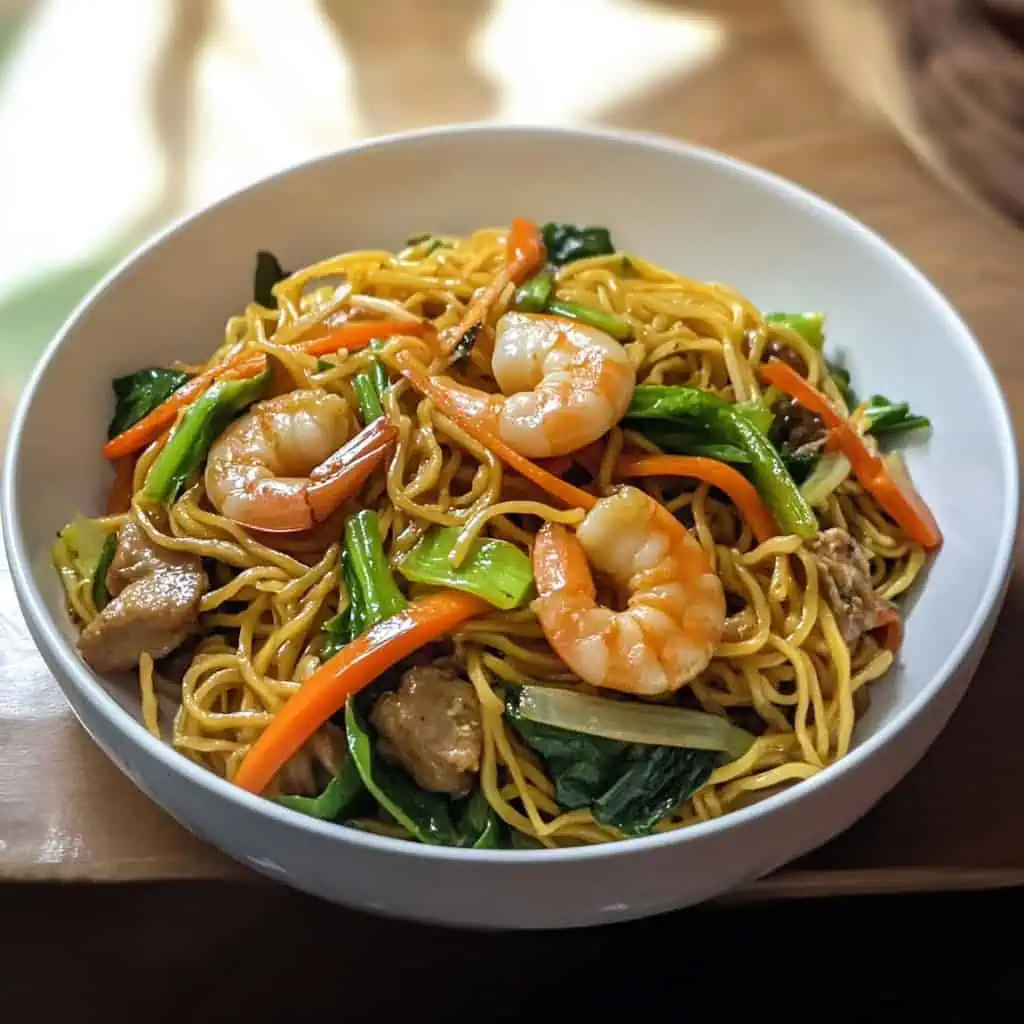





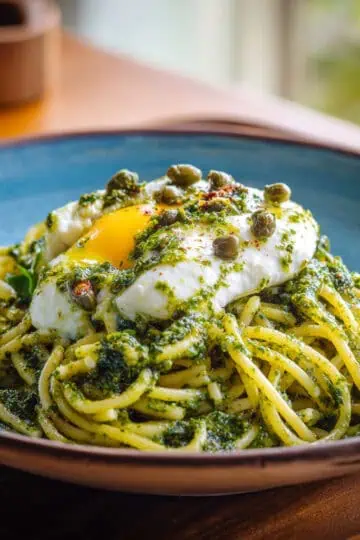
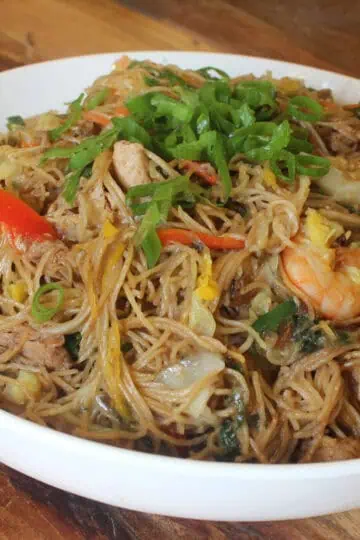
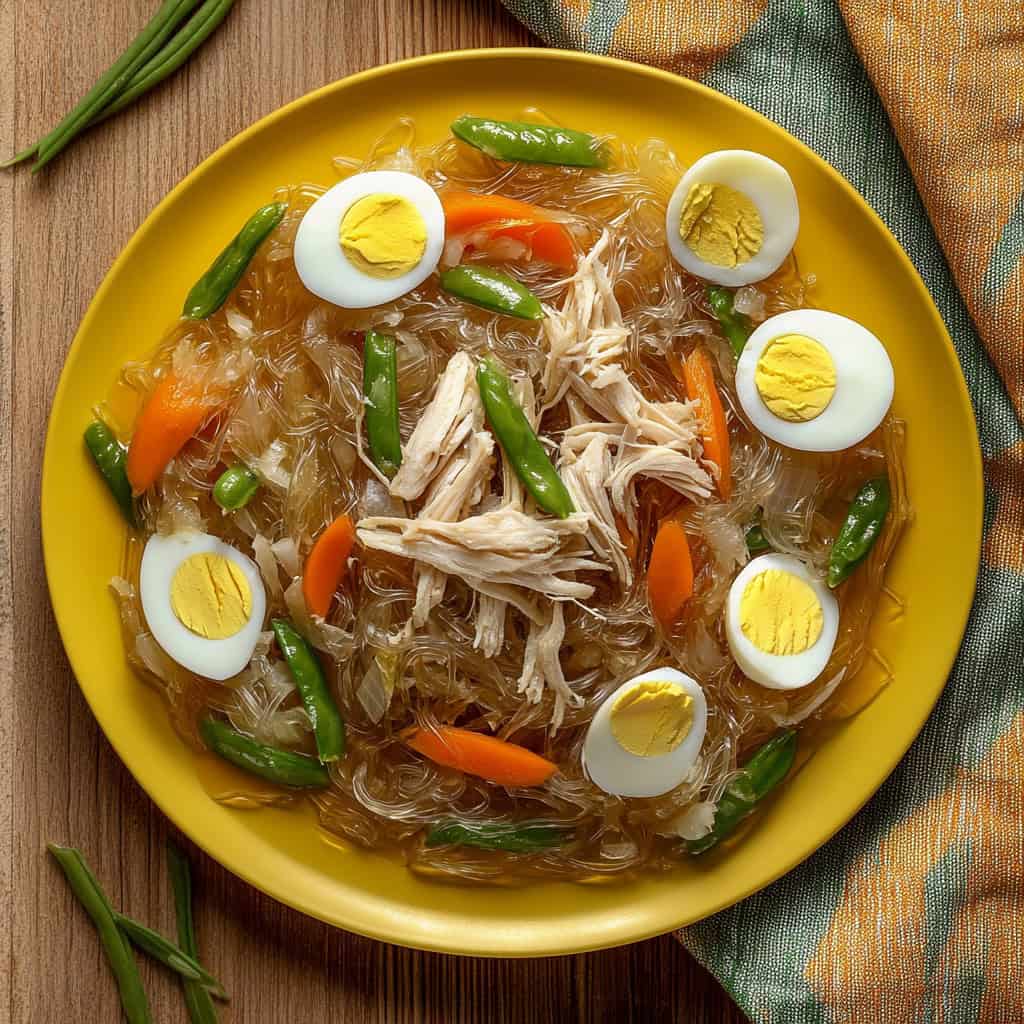
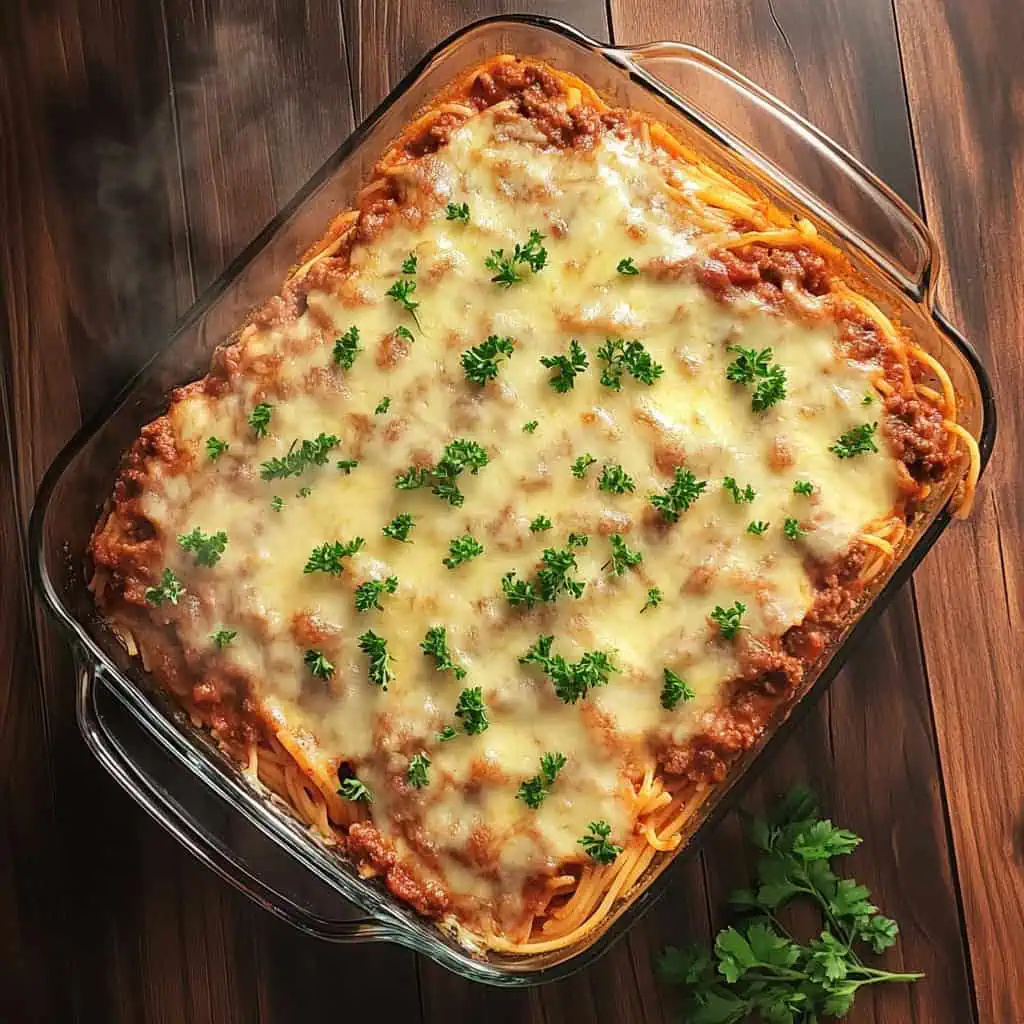
Comments
No Comments